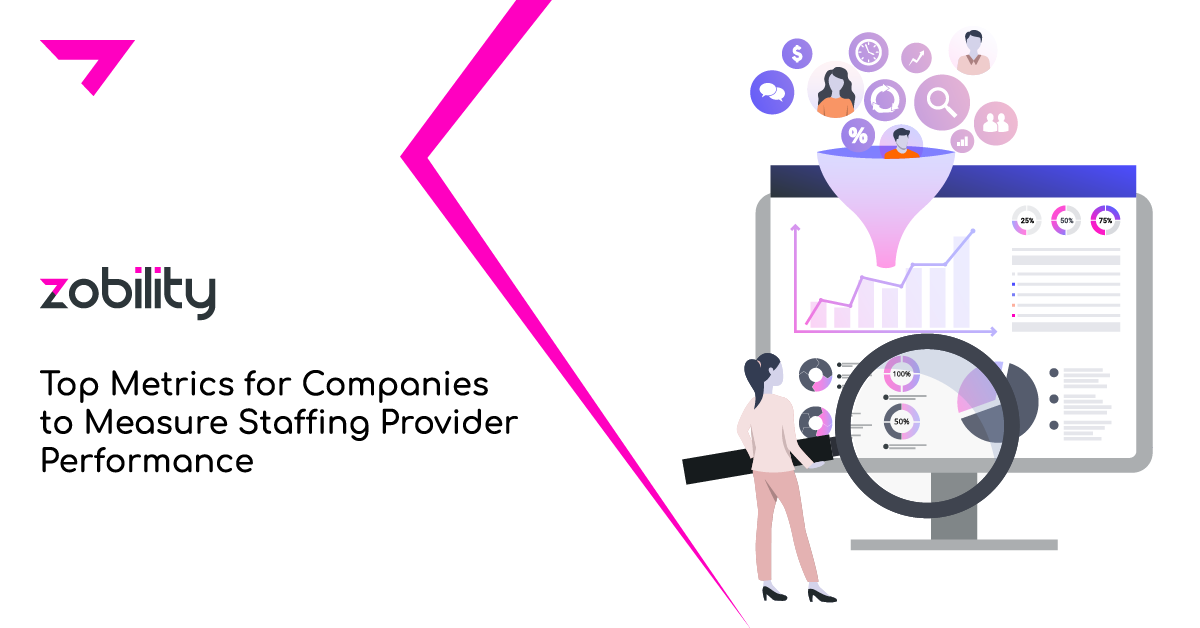Given the significant time and resources required for recruiting and hiring, many companies rely on external staffing agencies to streamline the process. Selecting the right staffing partner is just the first step toward a successful collaboration. To ensure that your staffing program continues to meet your evolving business needs, it’s important to regularly assess its performance. Here are the top metrics for companies to measure the effectiveness of their staffing providers in recruiting and hiring qualified candidates.
1. Time to Hire
Time to hire measures the number of days between when a job requisition is opened and when a candidate accepts the job offer. A shorter time to hire means your staffing partner is efficient and can quickly find the right talent for your needs.
How to Measure
Monitor the average time to hire for different roles and compare it with industry benchmarks. Look for trends over time and identify any bottlenecks in the hiring process that need addressing.
- Time to hire = # of days from candidate entering pipeline to candidate accepting job offer
- Average time to hire = (time to hire 1 + time to hire 2 + time to hire 3) / total number of hires
Example
You hired 3 employees with the following time to hire durations:
- Hire 1 – 30 days
- Hire 2 – 45 days
- Hire 3 – 60 days
Average time to hire = (30 + 45 + 60) / 3 = 45 days
2. Fill Rate
Fill rate measures the percentage of job orders filled by your staffing partner. A high fill rate indicates that your staffing partner is effectively sourcing and placing candidates for your open positions.
How to Measure
Calculate the fill rate by dividing the number of positions filled by the total number of job orders placed with the staffing agency. Aim for a fill rate that meets or exceeds industry standards.
- Fill rate = (number of positions filled / total number of job orders) x 100
Example
Out of the 50 job orders given to your staffing partner, 40 are filled.
Fill rate = (40/50) x 1200 = 80%
3. Retention Rate
The retention rate is an indicator of the long term success of your hires. High retention rates suggest that your staffing partner is providing candidates who are well matched to your company and committed to their roles.
How to Measure
Track the percentage of placed candidates who remain with your company for a defined period, such as six months or one year. Compare this rate to your overall employee retention rates to identify any discrepancies.
- Retention rate = (number of employees retained / total number of hires) x 100
Example
You hired 20 employees, out of which 15 stayed with the company for beyond 1 year.
Retention rate (first year) = (15 / 20) x 100 = 75%
4. Candidate Quality
performance and productivity. High- quality candidates are those who not only meet the job requirements but also fit well with your company culture and stay with the company long term.
How to Measure
Candidate quality can’t be captured by a single metric but rather assessed by using a variety of parameters. Evaluate candidate quality through feedback from hiring managers, performance reviews, and the retention rate of placed candidates. You can also use metrics such as the percentage of candidates who pass probationary periods or receive positive performance evaluations.
- Performance ratings – average performance ratings of new hires within the first year.
- Qualified candidates per opening – number of candidates that move past the first stage of the hiring process
- Retention rate (first year) = (number of employees retained for a year / total number of hires) x 100
Example
Out of your 10 job openings, 50 candidates moved past the first stage.
Qualified candidates (per opening) = 50 /10 = 5
5. Hiring Manager Satisfaction
The satisfaction of your hiring managers with the staffing partner’s services reflects the overall experience of working collaboratively, from candidate quality to communication and support.
How to Measure
Conduct regular surveys or interviews with hiring managers to gather feedback on their satisfaction levels. Look for consistent themes in their responses to identify strengths and areas for improvement.
- Average satisfaction score = (score 1 + score 2 + score 3…) / number of hiring managers
Example
You receive the following satisfaction scores (on a scale of 1-5) from 5 managers: 4, 5, 3, 4, 5.
Average satisfaction score = (4 + 5 + 3 + 4 + 5) / 5 = 4.2
6. Cost per Hire
Cost per hire measures the total expenditure incurred in the hiring process, including staffing agency fees, advertising costs, and onboarding expenses. Monitoring this metric helps you understand the cost effectiveness of your staffing partnership.
How to Measure
Calculate cost per hire by dividing the total hiring costs by the number of hires. Compare this to your budget and industry benchmarks to ensure you are getting value for your investment.
- Cost per hire = total hiring costs / number of hires
Example
Your total hiring costs are $50K for 10 hires.
Cost per hire = $50,000 / 10 = $5,000
7. Acceptance Rate
Acceptance rate is the percentage of job offers extended by your staffing partner that are accepted by candidates. A high acceptance rate indicates that the staffing partner is effectively matching candidates with roles that meet their expectations and needs, reflecting well on both the agency’s understanding of your requirements and its ability to present your company as an attractive employer.
How to Measure
Track the number of job offers accepted by candidates out of the total number of job offers extended. This metric helps you assess the attractiveness of the positions offered, the competitiveness of your compensation packages, and the efficiency of the staffing partner’s candidate selection process.
- Acceptance rate = (number of accepted offers / number of job offers extended) x 100
Example
Your staffing partner extended 50 job offers, of which 45 were accepted.
Acceptance rate = (45 / 50) x 100 = 90%
Conclusion
By regularly monitoring these KPIs, you can ensure that your staffing partnership remains effective and aligned with your business goals. These metrics provide valuable insights into the performance of your staffing partner and help you make data-driven decisions to optimize your talent acquisition strategy.
Maintaining a successful staffing partnership requires continuous evaluation and adjustment. By focusing on these KPIs, you can build a robust framework for measuring success and fostering a productive, long term relationship with your staffing agency.
About Zobility
Zobility, an RGBSI brand, focuses on providing innovative talent management solutions within the mobility and high-technology sectors. A range of our services include staff augmentation, managed service provider (MSP), vendor management (VMS), recruitment process outsourcing (RPO), and payroll administration.
Learn more about Talent Management Solutions
Download Talent Management Solutions Booklet
Follow us on LinkedIn







